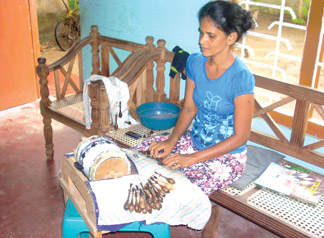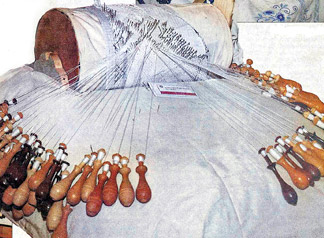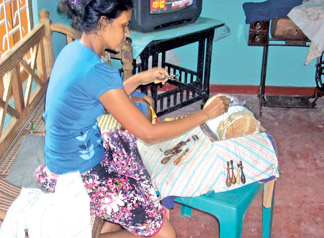
Beeralu sustained as a cottage industry
By Ananda KANNANGARA
 |

Beeralu lace on display |

Padmalatha making beeralu lace |
 |
The making of beeralu lace by villagers in the South commenced as a
cottage industry over 600 years ago. It was during the time when the
country was ruled by ancient kings and the industry became very popular
and active with the arrival of the Portuguese in the 16th century. This
cottage industry was thereafter developed by the Dutch who ruled the
country during the 17th century.
The legend says that the wives of ancient kings such as Dutugemunu,
Gajaba, Maha Parakramabahu, Devanampiyatissa and Kassapa were highly
impressed with beeralu lace, produced by our village folk in the
southern district. The royal wives used beeralu lace to their attire,
generally worn for special occasions. The legend also says that even
kings had admired the beeralu fixed clothes, worn by their wives.
The Portuguese arrived in the country during the 16th century and
they focused much attention towards the development of agriculture and
fishing industries. They also travelled all over the country and met
villagers with the objective of helping them to develop their self
employment projects. They identified that making beeralu lace was one of
the major industries in the rural sector and a large number of people
were engaged in the industry.
Our history also says that even Portuguese women highly admired
beeralu lace-fixed clothes. The Dutch arrived in the country in the 17th
century and they too helped the village folk to develop the industry.
The Dutch people had even taken measures to sell beeralu laced products
in foreign countries.
History also reveals that the beeralu industry is currently worked
off in every part of the country as self employment ventures, but the
origin of the beeralu industry comes from the South, even before the
colonial era.
A book on `Beeralu Lace in Ancient Ceylon’ says that Sri Lanka’s
beeralu industry has a long history of nearly 600 years. During the
early days women of fisher families living in the coastal belt of the
Southern Province made garments by looping yarn together with long
wooden needles fixed to hand made wooden machines. The products were
later called `Beeralu’ in Sinhala and ` Lace’ in English.
 |
| Tanuja with a
completed beeralu cloth. |
The book further says that the wives of fishermen were making beeralu
lace for long hours or days until their husbands arrived after fishing.
The Sunday Observer last week visited Mirissa, Magalle and Weligama,
the three most prominent areas in the country for beeralu lace–making.
According to manufacturers, over 500 families are engaged in the beeralu
lace-making industry in Matara, Galle, Makuluwa, Gandara, Dikwella and
Kottegoda in addition to Mirissa, Magalle and Weligama in the Southern
Province.
A 43-year-old prominent beeralu lace-manufacturer L.H. Padmalatha of
Magalle said she started the industry at the age of 14 during her
schooldays. She said she was trained in the art of beeralu lace-making
by her aunt P.H. Leelawathi.
“My aunt Leelawathi was a prominent and a keen beeralu maker in the
Magalle area and her only objective was to keep the industry alive. She
also started a beeralu-making class to train girls during evenings
everyday,”
She said beeralu lace-making and producing garments, window curtains,
pillow cases and other products fixed with beeralu lace are two
different industries.
Over 500 families are making beeralu lace, while another 40 families
buy the finished beeralu lace from them.
A resident of Magalle, 37-year-old A.G. Thanuja Dharshani said she
buys finished beeralu lace and produce tableclothes, cushion covers,
pillow cases and various other garment items with beeralu lace.
“I sell my products to an export company and I earn a monthly income
of Rs. 15,000 to 20,000”.
Thanuja said that she started the industry 12 years ago with the help
of her mother Prema Jayaweera and from her mother-in-law M.T. Malani.
She said her mother started the beeralu lace-making as a hobby 60
years ago and later it converted to a profit making industry.
She said it will be another dying industry unless support is given by
the authorities. According to Thanuja, beeralu lace manufacturers are
not in a sound financial position and it is the duty of authorities to
look into the development of this industry.
She also proposed authorities to start a school of beeralu lace
making and train school leavers, especially girls in the art of beeralu-making.
She also said the Chairman of the National Crafts Council,
Battaramulla, Buddhi Keerthisena helps beeralu lace manufacturers to
have their shops at the Crafts Village.
A mother of two children, 48-year-old Kanthi Padmini of Mirissa said
she has been in the beeralu making industry for the past 29 years and
request the Small Industry Ministry to send representatives to the
Southern Province to see the developments of the industry.
She also said the Government should make arrangements to export their
products and it will help protect this dying industry.
A mother of four children, Kalyani Muthmini of Gandhara said that
beeralu lace manufacturers are generally in need of finance to uplift
this industry and therefore requested authorities to provide them with
bank loans.
She also proposed the Small Industries Ministry to conduct regular
exhibitions in Colombo and other main cities for the benefit of beeralu
manufacturers, so that they could sell their products easily.
A prominent beeralu lace products seller, Mary Margerette said she
has a trade stall at the Craft Village, Battaramulla and earns a
satisfactory monthly income depending on the arrival of visitors,
especially foreigners.
She also proposed the authorities to allow beeralu makers to sell
their products at the Bandaranaike International Airport.
A prominent beeralu lace-maker Chithra Weerasinghe of Kottegoda said
that there are a number of famous beeralu manufacturers in the Province
such as Thilini lace, Kanthi lace and Harsha lace and urged the
Government to call upon all beeralu manufacturers in the province for a
meeting and discuss their problems, if the authorities really need to
protect this industry. She also said it was pathetic to note neither a
minister nor a single parliamentarian has visited beeralu
manufacturerers in the Southern Province other than during election
periods.
She therefore urged parliamentarians to visit beeralu lace
manufacturers and discuss their requirements.
|

